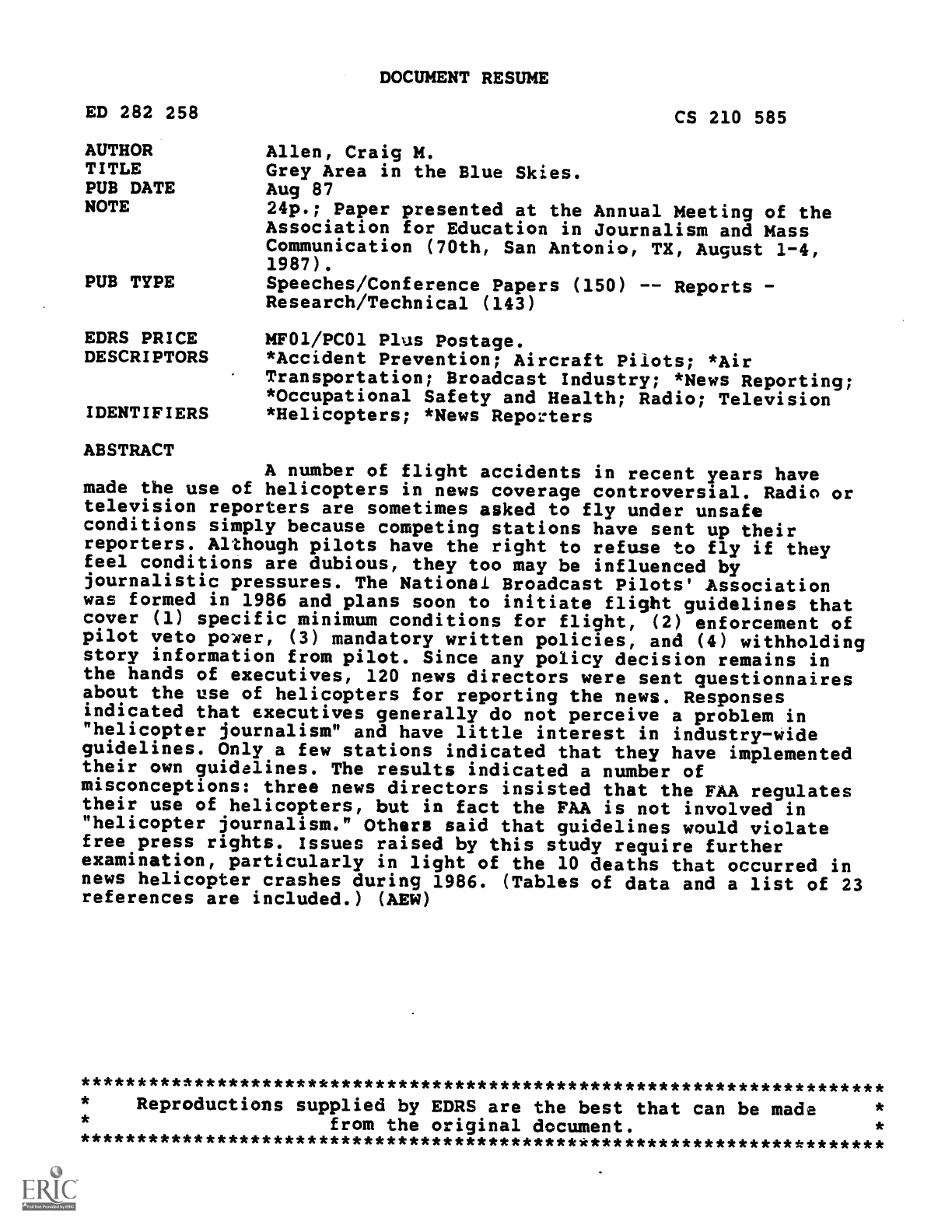
DOCUMENT RESUME
ED 282 258
CS 210 585
AUTHOR
Allen, Craig M.
TITLE
Grey Area in the Blue Skies.
PUB DATE
Aug 87
NOTE
24p.; Paper presented at the Annual Meeting of the
Association for Education in Journalism and
Mass
Communication (70th, San Antonio, TX, August 1-4,
1987).
PUB TYPE
Speeches/Conference Papers (150)
-- Reports -
Research/Technical (143)
EDRS PRICE
MF01/PC01 Plus Postage.
DESCRIPTORS
*Accident Prevention; Aircraft Pilots; *Air
Transportation; Broadcast Industry; *News Reporting;
*Occupational Safety and Health; Radio; Television
IDENTIFIERS
*Helicopters; *News Reporters
ABSTRACT
A number of flight accidents in recent
years have
made the use of helicopters in
news coverage controversial. Radio or
television reporters are sometimes asked
to fly under unsafe
conditions simply because competing stations
have sent up their
reporters. Although pilots have the right to refuse
to fly if they
feel conditions are dubious, they too
may be influenced by
journalistic pressures. The National Broadcast Pilots'
Association
was formed in 1986 and plans soon to initiate flight guidelines
that
cover (1) specific minimum conditions for flight, (2) enforcement of
pilot veto power, (3) mandatory written policies,
and (4) withholding
story information from pilot. Since
any policy decision remains in
the hands of executives, 120 news directors
were sent questionnaires
about the use of helicopters for reporting the
news. Responses
indicated that executives generally do
not perceive a problem in
"helicopter journalism" and have little interest in
industry-wide
guidelines. Only a few stations indicated that
they have implemented
their own guidelines. The results indicated
a number of
misconceptions: three news directors insisted
that the FAA regulates
their use of helicopters, but in fact the FAA is
not involved in
"helicopter journalism." Others said that guidelines
would violate
free press rights. Issues raised by this study require
further
examination, particularly in light of the 10
deaths that occurred in
news helicopter crashes during 1986. (Tables of data and
a list of 23
references are included.) (AEW)
***********************************************************************
*
Reproductions supplied by EDRS
are the best that can be made
*
*
from the original document.
*
***********************************************************************

RADIO-TV JOURNALISM
U.S. DEPARTMENT OF EDUCATION
Office Ol Educational Research and Improvement
EDUCATIONAL RESOURCES INFORMATION
CENTER (ERIC)
IIThis document has been reproduced as
eceived from the person or organization
originating it.
0 Minor changes have been made to improve
reproduction Quality
Points of view or opinions slated in this CIOCu
ment do not necessarily represent official
OERI position or policy.
GREY AREA IN THE BLUE SKIES
by
Craig M. Allen
Graduate Student
E.W. Scripps School of Journalism
Ohio University
Athens, Ohio
45701
(614) 592-5435
"PERMISSION TO REPRODUCE THIS
MATERIAL HAS BEEN GRANTED BY
Craig Allen
TO THE EDUCATIONAL RESOURCES
INFORMATION CENTER (ERIC)."
Paper presented
to the Radio-TV Journalism Division, Association
for Education in Journalism and Mass Communication
(AEJMC)
Annual Conference, San Antonio, Texas, August, 1987
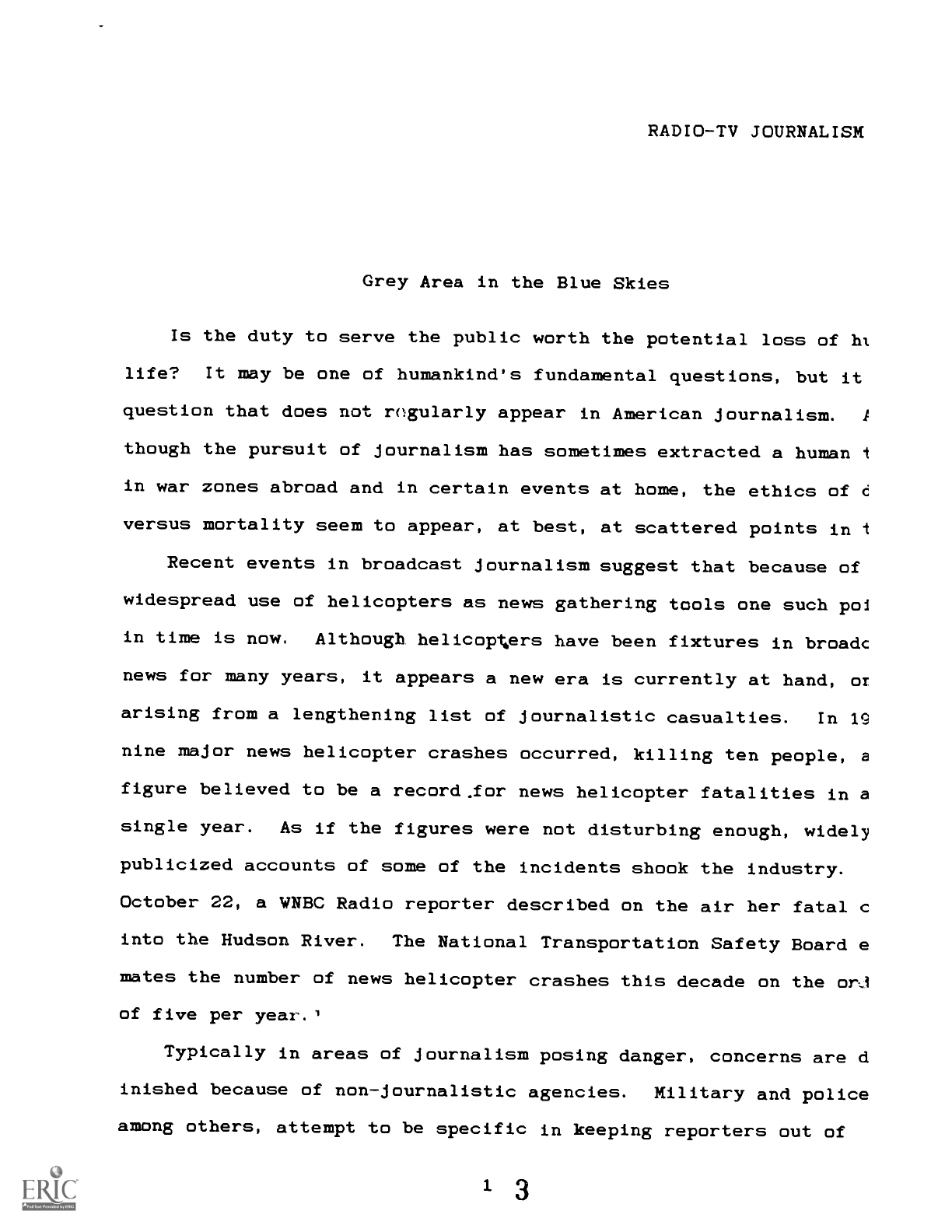
RADIO-TV JOURNALISM
Grey Area in the Blue Skies
Is the duty to serve the public worth the potential
loss of
life?
It may be one of humankind's fundamental questions,
but it
question that does not rngularly appear in American Journalism.
1
though the pursuit of Journalism has sometimes extracted
a human
in war zones abroad and in certain events at hone, the
ethics of C
versus mortality seem to appear, at best, at scattered points in 1
Recent events in broadcast Journalism suggest that
because of
widespread use of helicopters as news gathering tools
one such poi
in tine is now.
Although helicop%ers have been fixtures in broadc
news for many years, it appears a new era is currently at hand,
or
arising from a lengthening list of Journalistic
casualties.
In 19
nine major news helicopter crashes occurred, killing ten
people, a
figure believed to be a record.for
news helicopter fatalities in a
single year.
As if the figures were not disturbing enough, widely
publicized accounts of some of the incidents shook
the industry.
October 22, a WNBC Radio reporter described
on the air her fatal c
into the Hudson River.
The National Transportation Safety Board
e
mates the number of news helicopter crashes this
decade on the orJ
of five per year.,
Typically in areas of Journalism posing danger,
concerns are d
inished because of non-Journalistic agencies.
Military and police
among others, attempt to be specific in keeping reporters out
of
1
3

2
"harm's way."
This is not turning out to be true in helicopter
journalism.
The Federal Aviation Administration is active in licen-
sing pilots, rating hardware and coordinating airspace, but it does
not make news flying decisions.
Those are in the hands of people
running radio and television newsrooms.
The recent tragedies empha-
size the fact that the stakes can be very high.
This exploratory study attempts to show how the application of
helicopter journalism can be closely connected to "every day" news
judgment factors.
Such factors may fail to properly guide activities
with potential life-or-death consequences.
This is briefly traced
historically, as well as in discussion of a current movement in the
field toward establishing industry-vide guidelines.
From here, the
study presents results of a survey of broadcast news decision makers,
designed to (1) determine the current direction of helicopter journal-
ism,
(2) probe industry concerns and (3) suggest whether guidelines
would be supported.
The advent of helicopter journalism marked a step forward in the
ability of journalists to inform the public; coverage of events
ranging from impending natural disasters to daily traffic snarls
illustrates an important public function.1=
Yet, as often happens
when journalists take steps to better inform the public, grey areas
materialize.
In helicopter journalism, the grey area is narrow in
scope.
It does not embody broad questicns about whether helicopter
journalism should exist, but rather a single question, posed
on a
given day, in a given newsroom, of "should we fly?"
As will be shown,
many factors impinge on this question.
Although narrow in scope, there seems to be a certainty of heli-
copter journalism; its scale today is great. There is also
an inherent
4
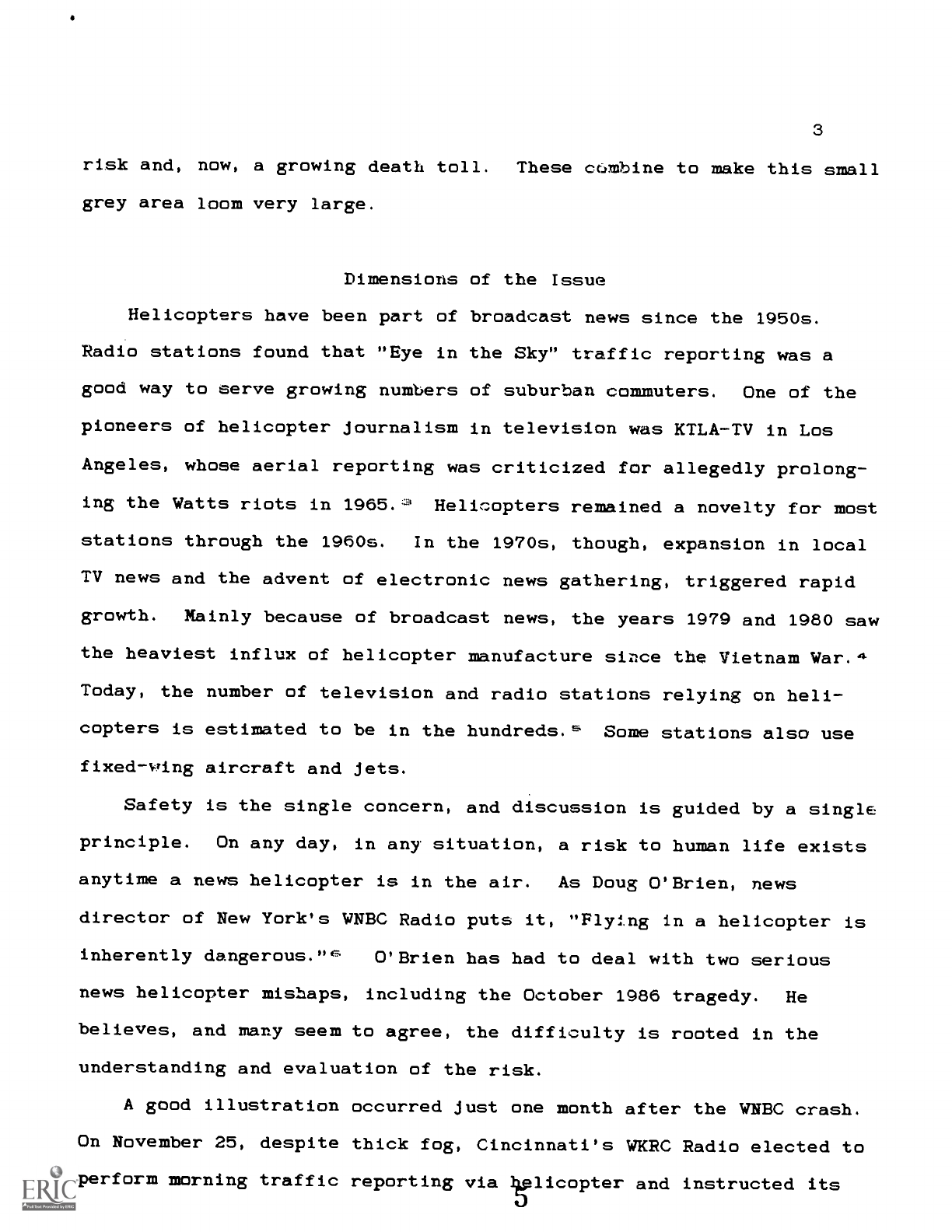
3
risk and, now, a growing death toll.
These combine to make this snall
grey area loom very large.
Dimensions of the Issue
Helicopters have been part of broadcast news since the 1950s.
Radio stations found that "Eye in the Sky" traffic reporting
was a
good way to serve growing numbers of suburban commuters.
One of the
pioneers of helicopter Journalism in television was KTLA-TV in Los
Angeles, whose aerial reporting was criticized for allegedly prolong-
ing the Watts riots in 1965.-'
Helicopters remained a novelty for most
stations through the 1960s.
In the 1970s, though, expansion in local
TV news and the advent of electronic
news gathering, triggered rapid
growth.
Mainly because of broadcast news, the years 1979 and 1980
saw
the heaviest influx of helicopter manufacture since the Vietnam
War..4
Today, the number of television and radio stations
relying on heli-
copters is estimated to be in the hundreds.
Sone stations also use
fixed-wing aircraft and Jets.
Safety is the single concern, and discussion is guided by
a single
principle.
On any day, in any situation, a risk to human life exists
anytine a news helicopter is in the air.
As Doug O'Brien, news
director of New York's WNBC Radio puts it, "Flying in
a helicopter is
inherently dangerous."E5
O'Brien bas had to deal with two serious
news helicopter mishaps, including the October 1986 tragedy.
He
believes, and many seem to agree, the difficulty is rooted in
the
understanding and evaluation of the risk.
A good illustration occurred Just one month after the WNBC
crash.
On November 25, despite thick fog, Cincinnati's WKRC
Radio elected to
perform naming traffic reporting via ricopter and
instructed its

4
crew into the air.
Moments after takeoff, the helicopter crashed into
a tree, killing reporter Nancy McCormick.
WKRC General Manager John
Soller indicated the decision to fly was apparently determined by the
fact that competing radio stations were airborne that morning.7
A somewhat different issue, and one apparently very common, is
depicted in the crash of a KREM-TV news helicopter in Spokane,
Washington, on May 5,
1985.
A crew was sent airborne solely to obtain
routine pictures of a road run.
Relevant video was easily achieved by
ground-based crews.
The helicopter became tangled in sone aerial guy
wires and crashed, killing pilot Cliff Richey and photographer Gary
Brown.°
Several components of the debate are found in the December 7,
1982, crash of a KOA-TV news helicopter near Denver.
During a driving
nighttime snow storm, pilot-reporter Karen Key and crew member Larry
Zane were killed shortly after being instructed to fly to the scene of
a downed airliner.
Questions about newsroom judgment arose again when
an autopsy showed that prior to flight Key was intoxicated and those
in the newsroom may have suspected it.
Subsequent news stories
revealed that Key had insufficient training, and several KOA staff
members had fears of flying with her, only to have those fears
rejected by management.
Critics speculated that Key, the only female
reporter-pilot in the nation at the tine, was hired to facilitate
station promotion during an intense "news war."
News Judgment, competitive forceo, complications of nature and
the intertwining of news and corporate self interest highlight parts
of the issue.
What makes the grey area more vexing is that helicopter
Journalism has few counterparts.
It appears caught in a vacuum
between aviation and Journalism.
6
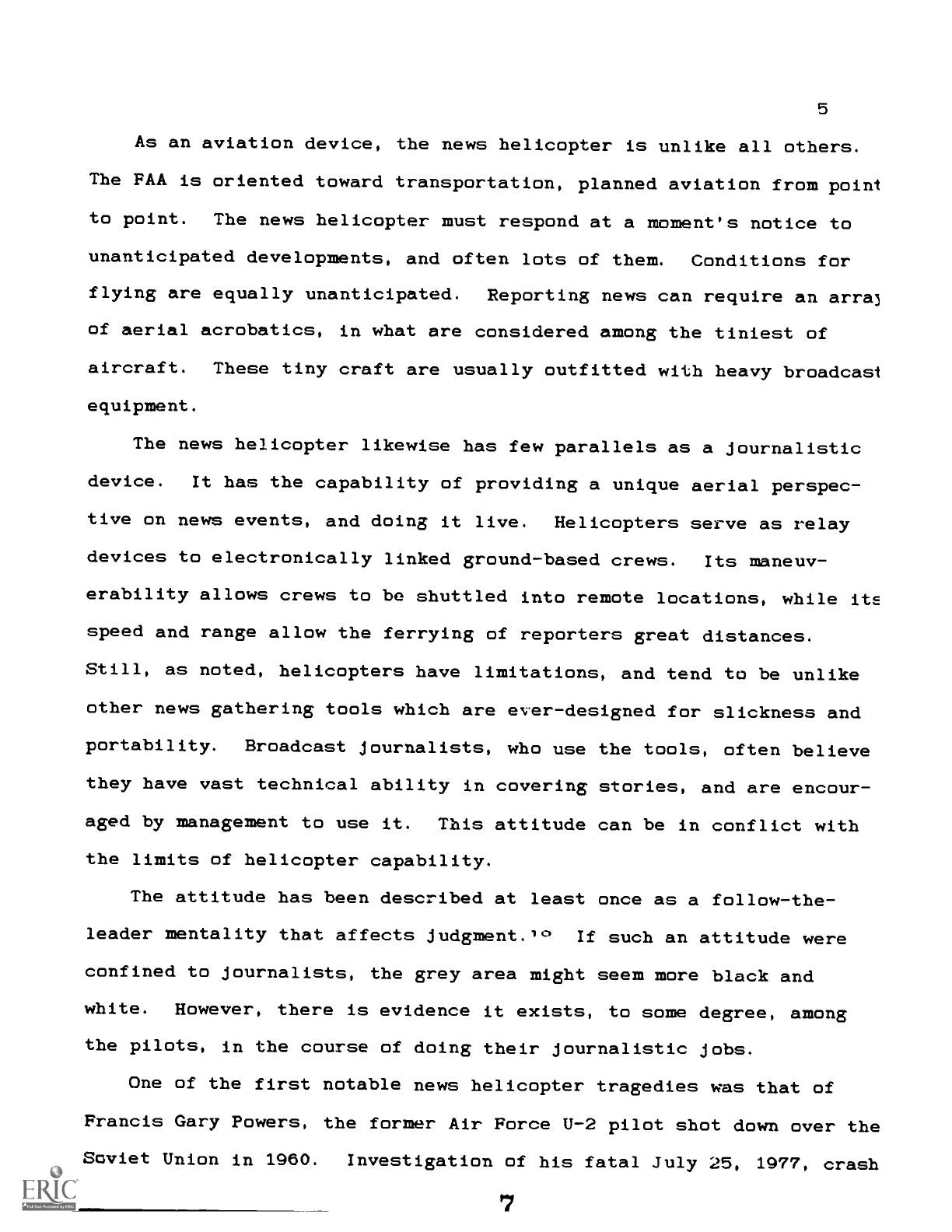
5
As an aviation device, the news helicopter is unlike all
others.
The FAA is oriented toward transportation,
planned aviation from point
to point.
The news helicopter must respond at
a moment's notice to
unanticipated developments, and often lots of them.
Conditions for
flying are equally unanticipated.
Reporting news can require an arra3
of aerial acrobatics, in what are considered among the tiniest of
aircraft.
These tiny craft are usually outfitted with heavy broadcasi
equipment.
The news helicopter likewise has few parallels
as a journalistic
device.
It has the capability of providing a unique aerial
perspec-
tive on news events, and doing it live.
Helicopters serve as relay
devices to electronically linked ground-based
crews.
Its maneuv-
erability allows crews to be shuttled into remote
locations, while itE
speed and range allow the ferrying of reporters great
distances.
Still, as noted, helicopters have limitations, and tend
to be unlike
other news gathering tools which are ever-designed for
slickness and
portability.
Broadcast journalists, who use the tools, often believe
they have vast technical ability in covering stories, and
are encour-
aged by management to use it.
This attitude can be in conflict with
the limits of helicopter capability.
The attitude has been described at least
once as a follow-the-
leader mentality that affects judgment.l°
If such an attitude were
confined to journalists, the grey area might
seem more black and
white.
However, there is evidence it exists, to some degree,
among
the pilots, in the course of doing their journalistic jobs.
One of the first notable news helicopter tragedies
was that of
Francis Gary Powers, the former Air Force U-2 pilot shot
down over the
Soviet Union in 1960.
Investigation of his fatal July 25, 1977, crash
'7

6
while flying for Los Angeles station KNBC-TV indicated his
news
helicopter had run out of fuel."
On May 27, 1980, near Seattle, a
helicopter owned by KIRO-TV collided in mid-air with an airplane
operated by KOMO Radio, an incident blamed on twin pilot error.
In
a January 21, 1986, crash in Minnesota, killing an ABC News crew, a
pilot is said to have ignored weather advisories.13
Denver's KUSA-TV
has witnessed two crashes since 1981.
A person who once supervised
the KUSA newsroom says of the pilot, "He always violated the rules.
They eventually had to fire him."1.4
What are "the rules?"
The FAA, again, has little to say on these
natters.
Nor do most local bodies, such as police agencies, which
might have a more direct tie with helicopter news organizations in a
given locale.
The relevant journalistic organization, the Radio-
Television News Directors Association, has nothing to say in its code
about aerial journalism or safety of news crews, nor has it conducted
a comprehensive study of the issue.'c
Safety considerations are
likewise not included in the code of ethics of the National Press
Photographers Association.'
Lacking anything more specific, what appears is a predominant rul(
of thumb, a sort of unwritten guideline.
It is the idea that once a
flying decision is made by the newsroom, the pilot has the authority
to say "no."
The matter ends up one of common sense, especially on
the part of the pilot.
Numerous news directors surveyed in this
study, in commenting on possible industry-wide guidelines, pointed to
this as solution.
Clearly, the vast majority of pilots may be
considered responsible.
However, does this really renove the slight-
est trace of question?
At least in cases cited here, there is indication that pilots may
8
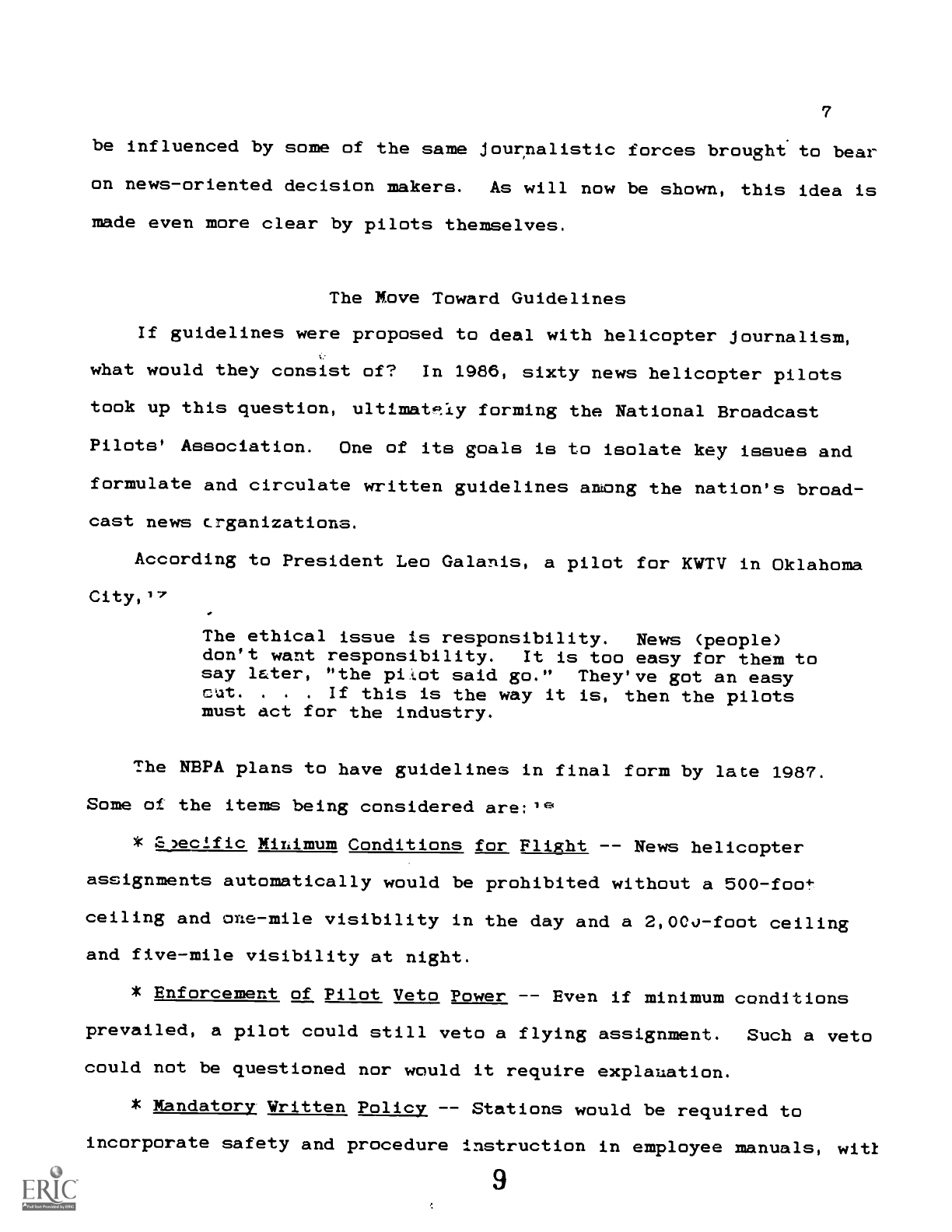
7
be influenced by some of the same Journalistic
forces brought to bear
on news-oriented decision makers.
As will now be shown, this idea is
made even more clear by pilots themselves.
The Move Toward Guidelines
If guidelines were proposed to deal with helicopter Journalism,
what would they consist of?
In 1986, sixty news helicopter pilots
took up this question, ultimatctly forming the National
Broadcast
Pilots' Association.
One of its goals is to isolate key issues and
formulate and circulate written guidelines
among the nation's broad-
cast news crganizations.
According to President Leo Galanis,
a pilot for KWTV in Oklahoma
City,"
The ethical issue is responsibility.
News (people)
don't want responsibility.
It is too easy for then to
say l&ter, "the pitot said go."
They've got an easy
cut.
. .
.
If this is the way it is, then the pilots
must act for the industry.
The NBPA plans to have guidelines in final form by
late 1987.
Some of the items being considered are:le
* ri)ecific MiLimum Conditions for Flight
News helicopter
assignments automatically would be prohibited without
a 500-foo+
ceiling and one-mile visibility in the day and
a 2,00o-foot ceiling
and five-mile visibility at night.
* Enforcement of Pilot Veto Power
Even if minimum conditions
prevailed, a pilot could still veto
a flying assignment.
Such a veto
could not be questioned nor would it require
explanation.
* Mandatory Written Policy
-- Stations would be required to
incorporate safety and procedure instruction in employee
manuals, witi
9

8
such policies to be explained to news personnel
upon hiring.
* T4ithholding Story Information from Pilot
-- A feeling exists
that the greatest source of pressure on pilots is journalistic.
lin&
this guideline, news personnel would be prohibited from explaining tl
the pilot the news value of any helicopter assignment, thus sparing
the pilot such consideration in flying decisions.
(Radio traffic
reporting would be excluded.)
A variety of sources is assisting the NBPA in this work.
One
source consists of hospitals, which maintain helicopter rescue units
Flight minimums have been established by hospitals,
as has the conce]
of withholding of information.
Galanis notes that many hospital
pilots are not told about the conditions of patients prior to making
flying decision.
Items dealing with the enforcement of veto power and mandatory
policies are being considered because they are already being employel
by some stations.
Nonetheless, the pilots did not undertake the effort without
points of initial concern, and at least two issues
seem at the fore-
front.
One is the contention that pilots are adversely influenced b:
newsroom competition.
Another is the idea that helicopter use is
excessive, and that many news assignments actually do not require
it.
Both problems were hinted in an informal poll of NBPA pilots in
mid 1986.19
Thirty-three responded.
Focusing on non-essential use,
three of the survey items dealt with nighttime assignments, somethil-q
TV pilots have questioned because of inherent lighting problems.-7-0
Without commenting on news judgments, all responding pilots said the:
were asked to fly over metropolitan areas at night, while eighty-five
percent had assignments over rural areas, where lighting is
worse.
10
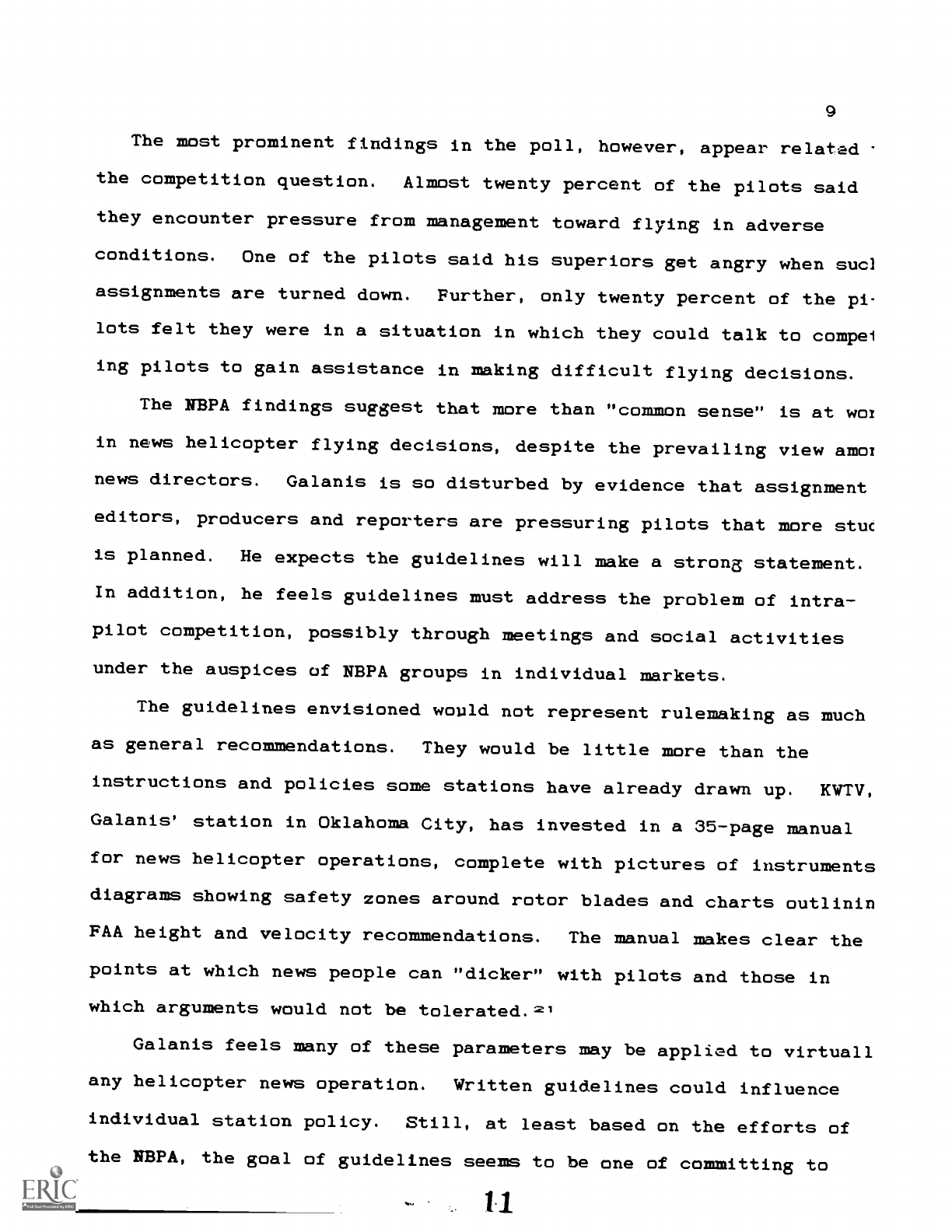
9
The most prominent findings
in the poll, however, appear related
the competition question.
Almost twenty percent of the
pilots said
they encounter pressure from
management toward flying in adverse
conditions.
One of the pilots said his
superiors get angry when sucl
assignments are turned down.
Further, only twenty percent of the pi-
lots felt they were in a situation in which
they could talk to compe1
ing pilots to gain assistance in naking
difficult flying decisions.
The NBPA findings suggest that
mare than "common sense" is at wox
in news helicopter flying decisions, despite
the prevailing view wool
news directors.
Galanis is so disturbed by evidence
that assignment
editors, producers and reporters
are pressuring pilots that mare stuc
is planned.
He expects the guidelines will
make a strong statenent.
In addition, he feels guidelines
must address the problem of intra-
pilot competition, possibly through
meetings and social activities
under the auspices of NBPA
groups in individual markets.
The guidelines envisioned would
not represent rulenaking
as much
as general recomnendations.
They would be little mare than
the
instructions and policies sone stations
have already drawn up.
KWTV,
Galanis' station in Oklahoma City,
has invested in a 35-page manual
for news helicopter operations,
complete with pictures of instrunents
diagrams showing safety
zones around rotor blades and charts outlinin
FAA height and velocity
recomnendations.
The manual nakes clear the
points at which news people
can "dicker" with pilots and those in
which arguments would not be
tolerated.2,
Galanis feels many of these paraneters
may be applied to virtuall
any helicopter news operation.
Written guidelines could influence
individual station policy.
Still, at least based
on the efforts of
the NBPA, the goal of guidelines
seens to be one of committing to
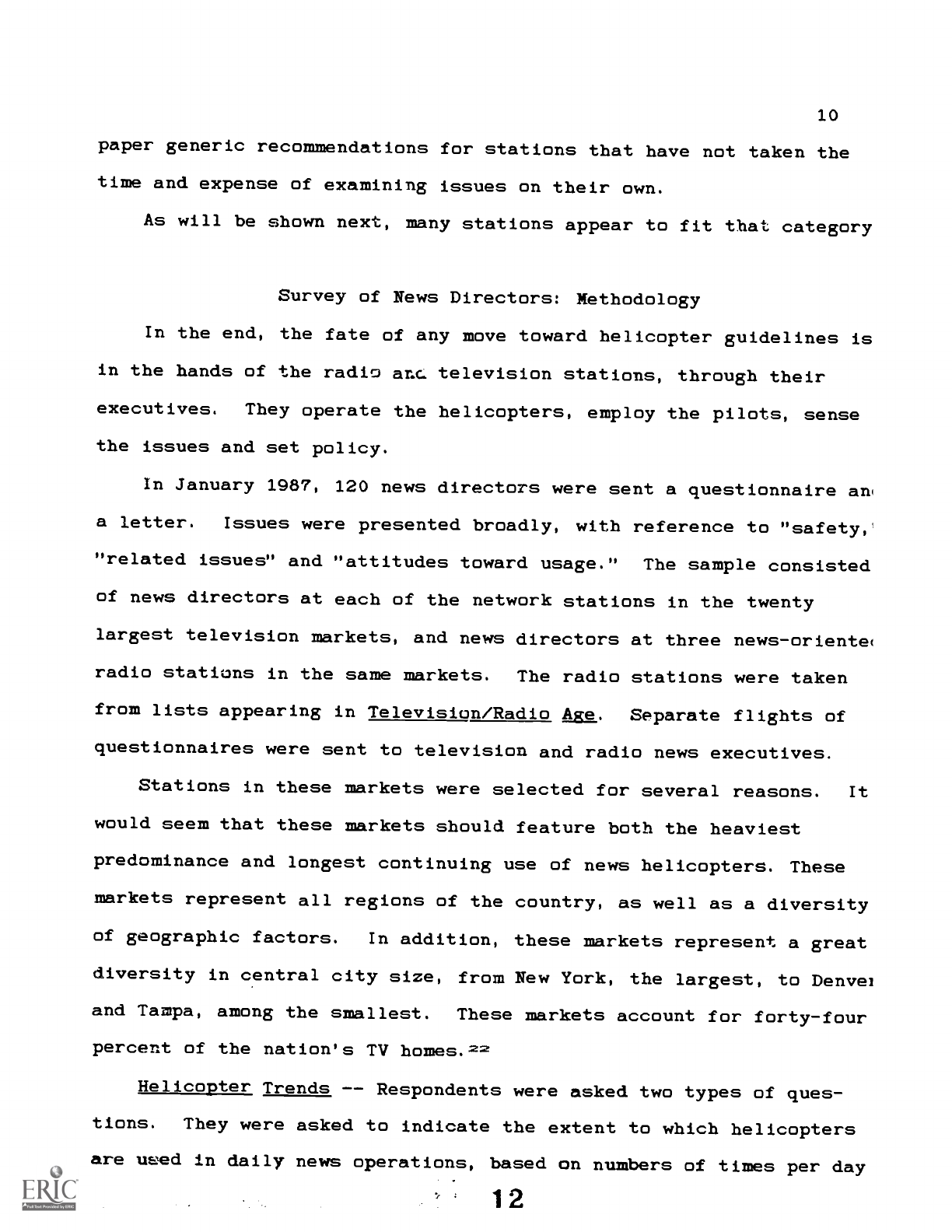
10
paper generic recommendations for stations that
have not taken the
time and expense of examining
issues on their own.
As will be shown next, many stations
appear to fit that category
Survey of News Directors: Methodology
In the end, the fate of any
move toward helicopter guidelines is
in the hands of the radio anc television
stations, through their
executives.
They operate the helicopters, employ the pilots,
sense
the issues and set policy.
In January 1987, 120 news directors
were sent a questionnaire an1
a letter.
Issues were presented broadly, with reference to
"safety,
"related issues" and "attitudes toward
usage."
The sample consisted
of news directors at each of the network
stations in the twenty
largest television markets, and
news directors at three news-oriente(
radio stations in the sane markets.
The radio stations were taken
from lists appearing in Television/Radio
Age.
Separate flights of
questionnaires were sent to television and radio
news executives.
Stations in these markets
were selected for several reasons.
It
would seem that these markets should feature
both the heaviest
predominance and longest continuing
use of news helicopters. These
markets represent all regions of the country,
as well as a diversity
of geographic factors.
In addition, these markets represent
a great
diversity in central city size, from New
York, the largest, to Denvel
and Tampa, among the smallest.
These markets account for forty-four
percent of the nation's TV homes..2,2
Helicopter Trends
-- Respondents were asked two types of ques-
tions.
They were asked to indicate the extent to which
helicopters
are msed in daily news operations, based
on numbers of times per day
1 2
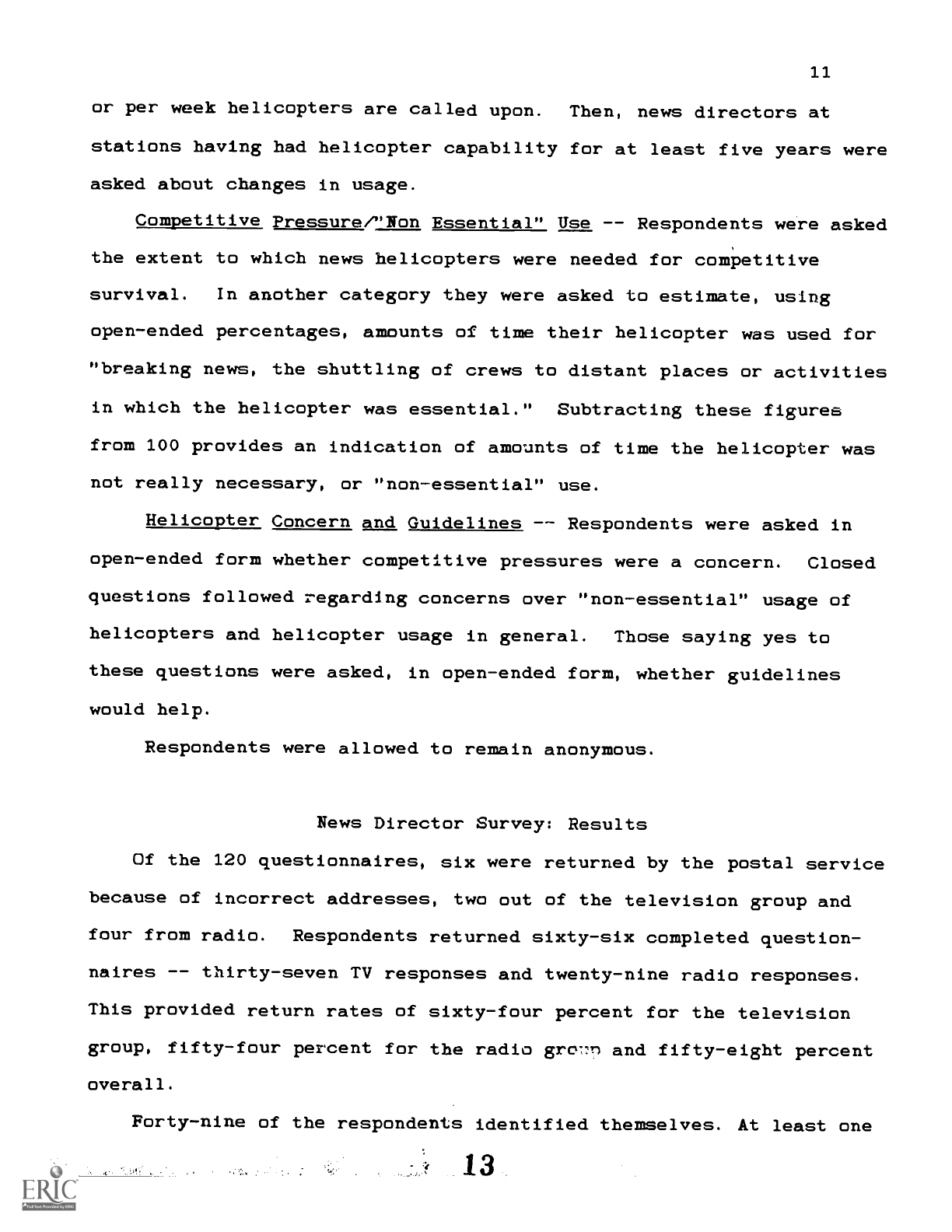
11
or per week helicopters are called upon.
Then, news directors at
stations having had helicopter capability for at least five years
were
asked about changes in usage.
Competitive Pressure/"Non Essential" Use
Respondents were asked
the extent to which news helicopters were needed for competitive
survival.
In another category they were asked to estimate, using
open-ended percentages, amounts of tine their helicopter was used for
"breaking news, the shuttling of crews to distant places or activities
in which the helicopter was essential."
Subtracting these figures
from 100 provides an indication of amounts of time the helicopter
was
not really necessary, or "non-essential" use.
Helicopter Concern and Guidelines
-- Respondents were asked in
open-ended form whether competitive pressures were
a concern.
Closed
questions followed regarding concerns over "non-essential"
usage of
helicopters and helicopter usage in general.
Those saying yes to
these questions were asked, in open-ended form, whether guidelines
would help.
Respondents were allowed to remain anonymous.
News Director Survey: Results
Of the 120 questionnaires, six were returned by the postal
service
because of incorrect addresses, two out of the television
group and
four from radio.
Respondents returned sixty-six completed question-
naires
thirty-seven TV responses and twenty-nine radio responses.
This provided return rates of sixty-four percent for the television
group, fifty-four percent for the radio gre;m and fifty-eight percent
overall.
Forty-nine of the respondents identified themselves. At least
one
13
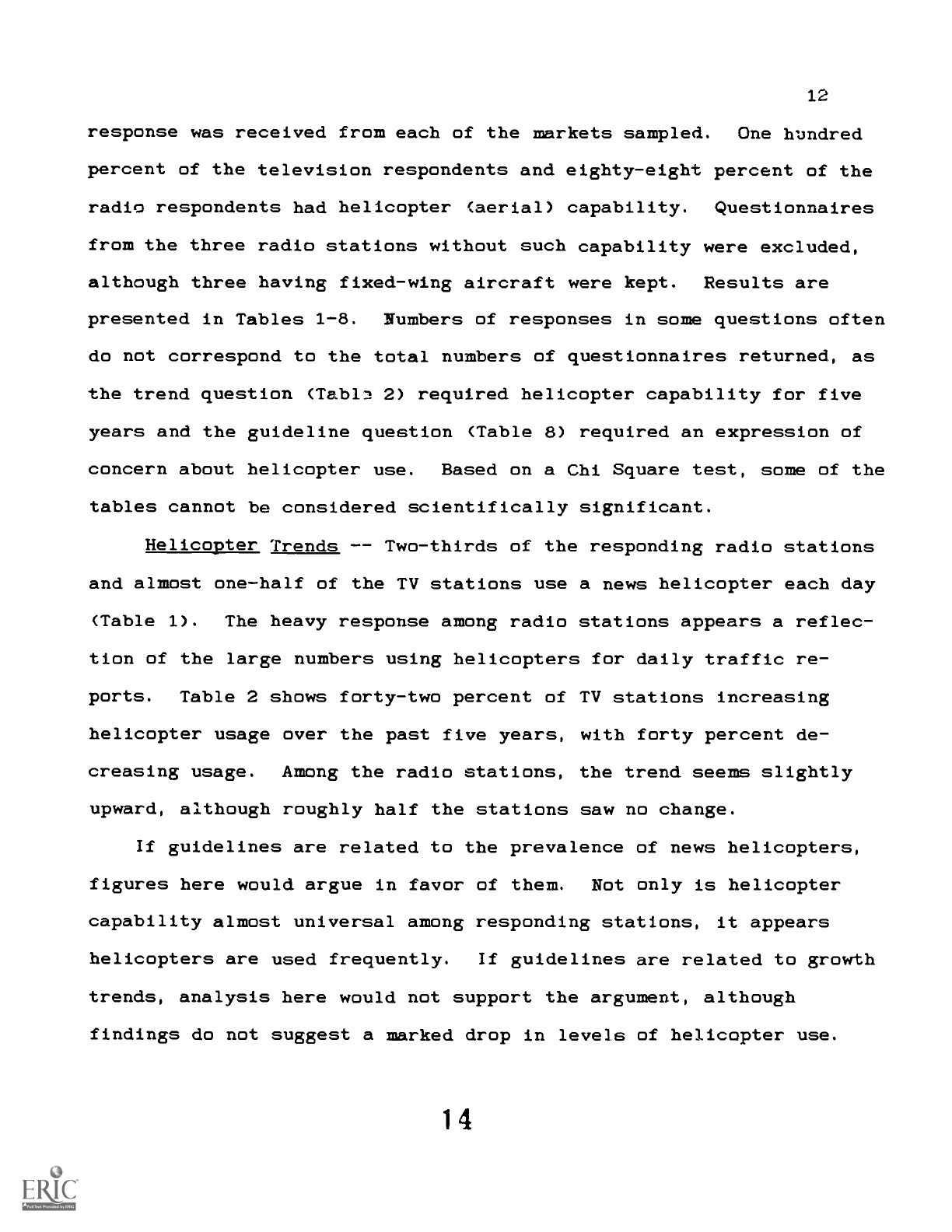
12
response was received from each of the markets sampled.
One hundred
percent of the television respondents and eighty-eight percent of the
radio respondents had helicopter (aerial) capability.
Questionnaires
from the three radio stations without such capability were excluded,
although three having fixed-wing aircraft were kept. Results are
presented in Tables 1-8. Numbers of responses in sone questions often
do not correspond to the total numbers of questionnaires returned, as
the trend question (Tabln 2) required helicopter capability for five
years and the guideline question (Table 8) required an expression of
concern about helicopter use.
Based on a Chi Square test, sone of the
tables cannot be considered scientifically significant.
Helicopter Trends
Two-thirds of the responding radio stations
and almost one-half of the TV stations use a news helicopter each day
(Table 1).
The heavy response among radio stations appears a reflec-
tion of the large numbers using helicopters for daily traffic re-
ports.
Table 2 shows forty-two percent of TV stations increasing
helicopter usage over the past five years, with forty percent de-
creasing usage.
Among the radio stations, the trend seens slightly
upward, although roughly half the stations saw no change.
If guidelines are related to the prevalence of news helicopters,
figures here would argue in favor of them.
Not only is helicopter
capability almost universal among responding stations, it appears
helicopters are used frequently.
If guidelines are related to growth
trends, analysis here would not support the argument, although
findings do not suggest a marked drop in levels of helicopter use.
1 4

13
TABLE 1: USAGE OF HELICOPTERS
Television
(N=37)
Radio
(N=25)
Each Day
45%
69%
Once Per Week
35%
8%
Every Other Week
5%
0%
When Applicable
8%
15%
No Response
5%
8%
X2=4.82, df=1,
p<.05
"Once Per Week," "Every Other Week" and "When Applicable"
were combined in order to obtain minimum cell expected
values.
"No Response" was excluded in the test.
TABLE 2:
FIVE-YEAR TREND
Television
(N=35)
Radio
(N=20)
Increased Significantly
15%
15%
Increased Somewhat
27%
20%
Remained the Sane
19%
45%
Decreased Somewhat
27%
10%
Decreased Significantly
13%
5%
No Response
0%
5%
X-7'=4.80, df=1
,
p<.05
"Increased Significantly" and "Increased Somewhat"
were
combined, and "Decreased Somewhat" and "Decreased
Significantly"
were combined in order to obtain minimum cell expected values.
"No Response" was excluded in the test.
Competitive Pressure/"Non Essential" Use
-- Results in the
competitive survival analysis (Table 3)
are striking, and would give
strong support for guidelines based on the idea of
competitive
influence.
Eighty-three percent of the television stations and
sixty-two percent of the radio stations view
helicopters as competi-
tive implements.
In the "non-essential" news analysis (Table
4), results are nut
scientifically significant, but worthy of note.
As such, they do not
provide dramatic slIpport for guidelines based
on "non-essential" use.
Among TV respondents, twenty-two percent claimed to
never use helicop-
1 5

14
ters in "non-essential" situations, while more than half said they did
it ten percent of the tine or less.
In the radio category, traffic re-
porting was considered "essential."
With that, more than half the
respondents listed "non-essential" use at the ten percent level or
less.
TABLE 3: HELICOPTER FOR COMPETITIVE SURVIVAL
Television
(N=37)
To a Great Extent 37%
Radio
(N=26)
27%
Somewhat of a Factor
46%
35%
Not a Factor 11%
12%
No Response
6% 27%
r2=4.45, df=2, nsd
"No Response" was excluded in the test.
TABLE 4: "NON ESSENTIAL NEWS"
0 Percent of the Time
1-10 Percent of the Tine
11-20 Percent of the Time
21-30 Percent of the Time
More Than 31 Percent Gf Time
No Response
Television
Radio
(N=37) (N=26)
22%
23%
31%
12%
15%
15%
4
43%
24%
8%
3%
0%
)F=5.14, df=3, nsd
"11-20," "21-30" and "More Than 31" were combined in
order to obtain minimum cell expected values.
"No Response"
was excluded in the test.
Helicopter Concern and Guidelines
The final four analyses
examine feelings and possible decision-making attitudes among the news
executives.
These tables are not scientifically significant, although
results point in a coherent direction.
Results suggests no prominent
concern among the news directors regarding helicopter news usage.
Among thcse who did note concern, support for the establishment of
guidelines was mixed.
In the open-ended question about competitive
concerns (Table 5), only twenty-seven percent of the TV respondents
16
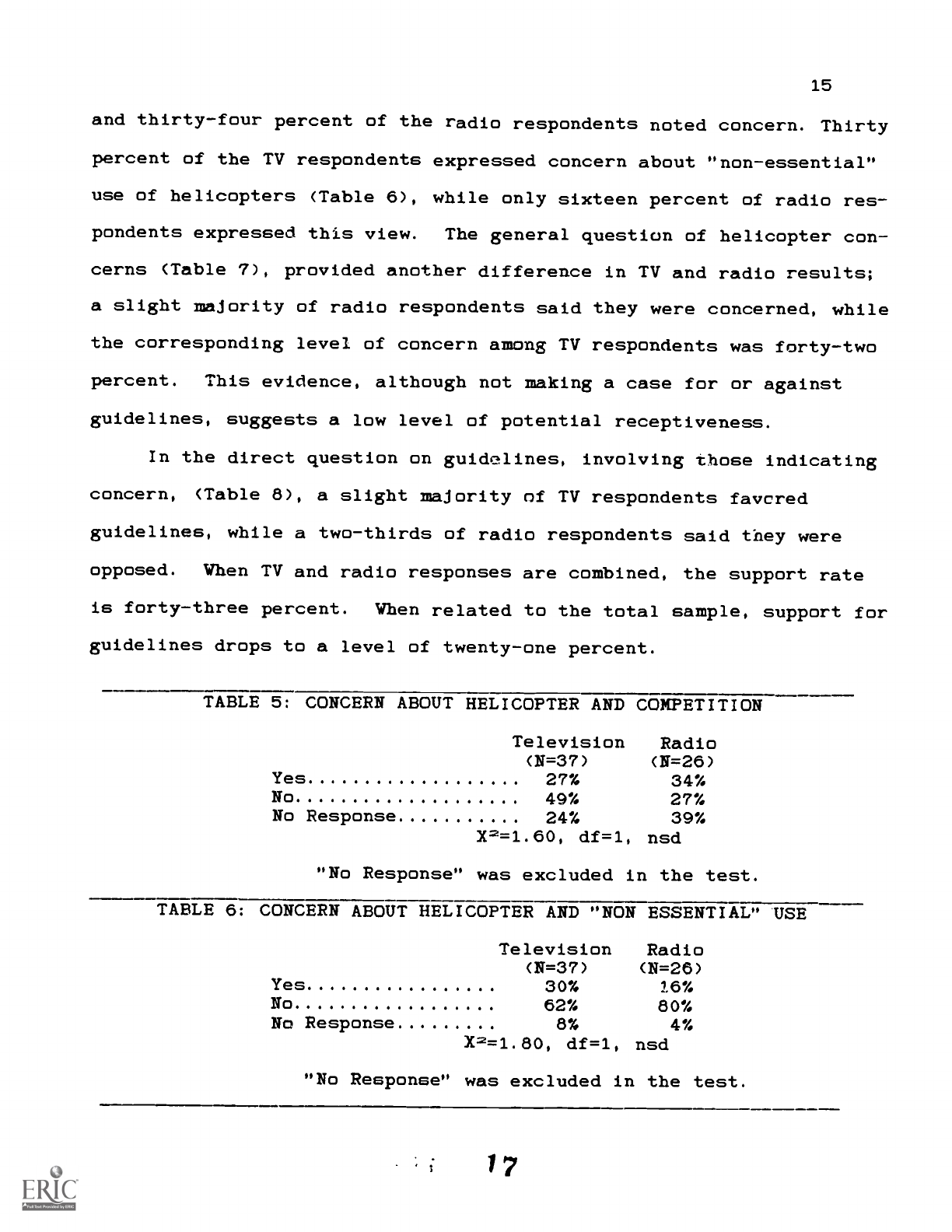
15
and thirty-four percent of the radio respondents
noted concern. Thirty
percent of the TV respondents expressed
concern about "non-essential"
use of helicopters (Table 6), while only sixteen percent of radio
res-
pondents expressed this view.
The general question of helicopter con-
cerns (Table 7), provided another difference in TV and radio results;
a slight majority of radio respondents said they were concerned, while
the corresponding level of concern among TV respondents
was forty-two
percent.
This evidence, although not making a case for or against
guidelines, suggests a low level of potential receptiveness.
In the direct question on guidelines, involving those indicating
concern,
(Table 8), a slight majority of TV respondents favcred
guidelines, while a two-thirds of radio respondents said they
were
opposed.
When TV and radio responses are combined, the support
rate
is forty-three percent.
When related to the total sample, support for
guidelines drops to a level of twenty-one percent.
TABLE 5: CONCERN ABOUT HELICOPTER AND COMPETITION
Television
Radio
(N=37)
(ff=26)
Yes
27%
34%
No
49%
27%
No Response
24%
39%
X=1.60, df=1, nsd
"No Response" was excluded in the test.
TABLE 6: CONCERN ABOUT HELICOPTER AND "NON ESSENTIAL" USE
Television
Radio
(N=37) (N=26)
Yes
30%
16%
No
62%
80%
No Response
8%
4%
X=1.80, df=1, nsd
"No Response" was excluded in the test.
17
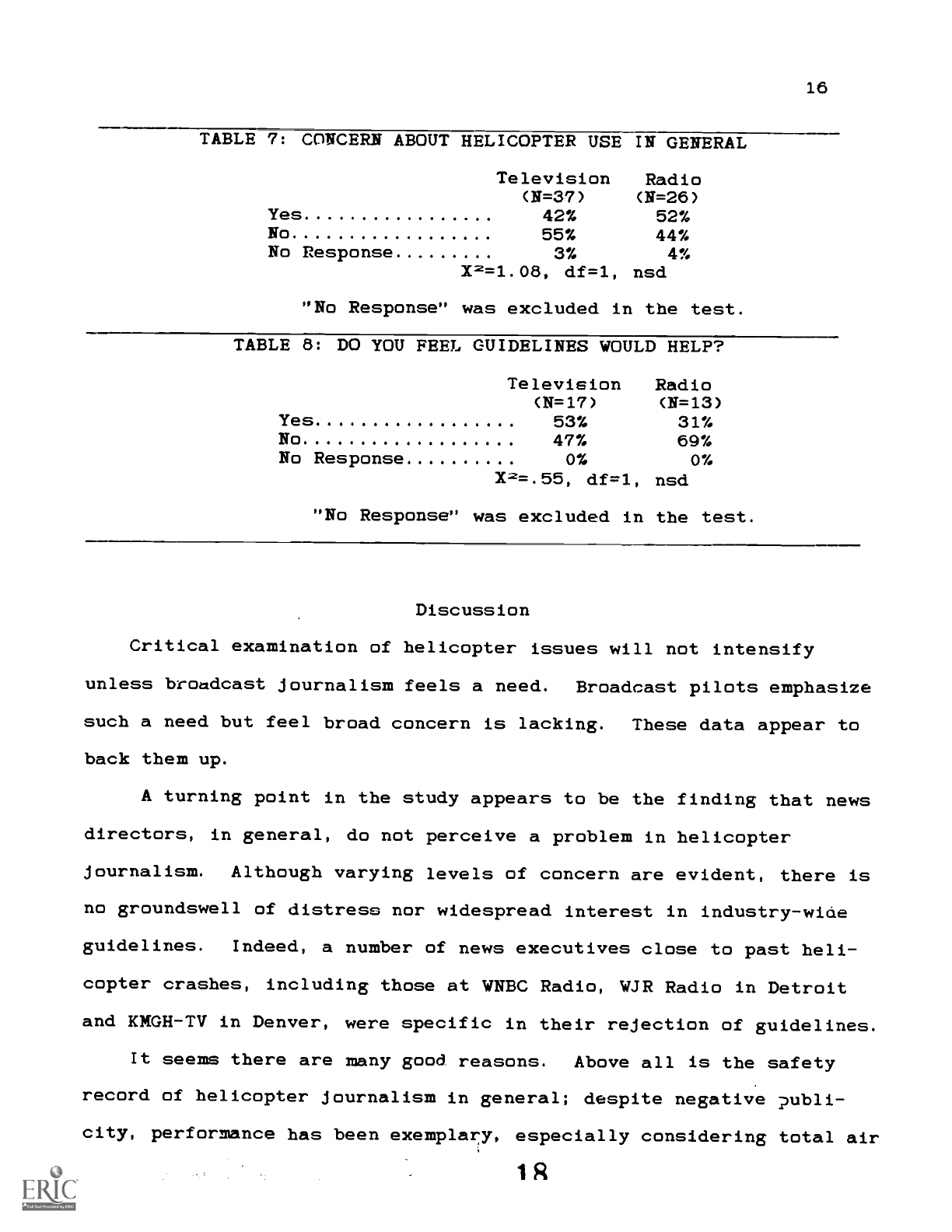
16
TABLE 7: CONCERN ABOUT HELICOPTER USE IN GENERAL
Television
Radio
(N=37)
(N=26)
Yes
42%
52%
No
55%
44%
No Response
3%
4%
X=1.08, df=1, nsd
"No Response" was excluded in the test.
TABLE 8: DO YOU FEEL GUIDELINES WOULD HELP?
Television
Radio
(N=17)
(N=13)
Yes
53% 31%
No
47%
69%
No Response
0%
0%
X2=.551 df=1, nsd
"No Response" was excluded in the test.
Discussion
Critical examination of helicopter issues will not intensify
unless broadcast journalism feels a need.
Broadcast pilots emphasize
such a need but feel broad concern is lacking.
These data appear to
back them up.
A turning point in the study appears to be the finding that
news
directors, in general, do not perceive a problem in helicopter
journalism.
Although varying levels of concern are evident, there is
no groundswell of distress nor widespread interest in industry-wine
guidelines.
Indeed, a number of news executives close to past heli-
copter crashes, including those at WNBC Radio, WJR Radio in Detroit
and KMGH-TV in Denver, were specific in their rejection of
guidelines.
It seems there are many good reasons.
Above all is the safety
record of helicopter journalism in general; despite negative ?ubli-
city, performance has been exemplary, especially considering total
air
1 R

17
hours and conditions of flight.
Regarding guidelines, four of the
respondents maintained they would fail because
sonic_ stations would
eventually violate them.
Another recurring contention was the idea
that idiosyncrasies in individual markets would preclude
a boilerplate
solution.
Four respondents commented on that possibility directly.
Elsewhere in the survey questions, other points were raised.
Two
news executives rejected guidelines, saying they would resist any
outside effort to set policy in their newsrooms,
one saying it
violated free press rights.
Several respondents argued that the
use
of news helicopters may be on the verge of decline.
Two felt the
promotional hoopla about helicopters has long passed.
Five of the
television respondents related that satellite
news gathering has
reduced the logistics and timing problems of covering events
in
distant locations.
SNG is now limited to a relative handful of
stations, but as it expands, it.could reduce helicopter
usage.
However, future direction of helicopter journalism
was discussed
in a much different light by two news directors at NBC-owned
radio
stations.
As a result of the WNBC crash, the network has temporarily
grounded all of its helicopter radio operations and is
strongly
considering terminating them.
Related to this is another factor, not
described by any of the respondents, but opened up by Galanis and the
pilots.
That has to do with an expected increase in insurance rates
brought about by the recent crashes.
These factors are noteworthy.
While possibly part of an anti-guideline rationale, they
nonetheless
argue the opposite way, toward the need for industry-wide examina-
tion.
Otherwise, helicopters may be taken away from journalism
altogether,
19

18
There may indeed be impelling reasons why
a majority of news
directors do not see value in this discussion.
The study, however,
began on the premise that helicopter journalism
does not embody broad
questions, but rather a narrow one.
In spite of the rising casualty
rate, respondents tend to see the present situation
as adequate.
Does
this mean that all reasonably doubt is removed?
The study indicates it does not.
This is shown in the responses
of the small number of news executives who
did favor guidelines.
Jim
Hale of WHK-WMMS Radio in Cleveland states that FAA
regulations are
not specific.
Bob Reichblum of WJLA-TV in Washington points to
prevalent misuse and danger.
Mark Young of WJBK-TV in Detroit feels
"sone pilots blatantly disobey instructions from officials."
Bob
Salsberg of WBZ Radio in Boston is concerned about the "non
essential"
use issue.
John G. Rodman of WEEI Radio in Boston sees ambiguity in
weather-related flying conditions.
A good case for guidelines, at least within the
scope of this
study, is found in responses from Dianne Fukami of KPIX-TV
and Darrel
R. Compton of KRON-TV- both in San Francisco.
Stations there have
implemented a series of market-wide guidelines, taking
in some of the
ideas previously discussed.
Both noted intense competitive influences
and, in this setting, Compton declares, "it's been
a great help."
Nevertheless, what may be the best supporting
case here is
something completely different.
It has to do with a startling level
of misconception regarding fundamental points,
reflected in the
questionnaire.
Three news directors flatly stated that FAA regula-
tions guide their use of helicopters.
Another said that industry-wide
guidelines on news helicopter safety standards
are "on the books,"
while another said there are too many guidelines
on helicopters
20

19
already.
Meanwhile, six of the news directors responded to
the effect
that "common sense" was guideline enough.
The noted regulations and
guidelines do not seem to exist, and "common sense"
is precisely the
concept rousing the animosity of their pilots.
Galanis sees the
management attitude as one of gross oversimplification,
The FAA guidelines are vague.
In all cases the pilot
by himself makes the final decision.
If the pilot
doesn't fly for three or four days there is
pressure
from the station.
It puts the pilot in a bad posi-
tion.
He says to himself, "They told ne if
I didn't go
I'd be fired."
Galanis says news directors are poorly informed
on helicopter
matters, but he does not blame them.
To him, the central problem is
inadequate communication among pilots,
news dixectorG and day-to-day
journalists.
Indeed, he sees the gnidelines being drawn
up by the
NBPA as an informational device.
"We're not out to create rules and
regulations," he says, "just something
we can go by."
The study leaves much open for further pursuit.
Several news
directors said a key aspect of the issue is ownership,
the idea that
outright ownership of a helicopter is preferable
to rental agree-
ments.
Indeed, the survey indicates that seventy-five
percent of the
television stations and eighty percent of the
radio stations relied on
rentals.
It might also be worthwhile to probe differences
in TV and
radio orientations toward h 'icopters.
At present, the NBPA is not
seeking members among radio pilots.
Such differences were hinted in
many of the results, including the question
on concern about "non
essential" uses.
Far more TV respondents than radio respondents
expressed concern, sone writing
on the questionnaire they did not feel
all radio traffic reporting was essential.
Based on the survey, radio
news directors would disagree.
-
2 1

20
Beyond this, it appears that
many specific issues related here,
such as competitive influences,
news flying decision making, the
promotional yield of helicopter Journalism and
newsroom commmnication
could kindle extensive discussion individually.
This might especially
be true in the immediate future, with the NBPA
working to heighten
concern.
A number of other considerations turned
up, including
dangers posed by helicopters to people
on the ground and newsroom
budget factors.
They seem points for further research.
Issues raised in this study really only involve
a small number of
Journalists, in a very unique news gathering
situation.
Yet, as
unique as they might be, they touch
one of the deepest planes of
discussion, that dealing with the potential
loss of life.
News
organizations seldom see their daily duties in
this light.
Neverthe-
less, the ten people who died in
news helicopter crashes in 1986
suggests this may be a valid perspective.
It seems safe to conclude that such discussion
would be useful.
It is an issue of Journalism, and
no one consulted in this study sees
it any other way.
As one of the radio news directors stated, "We
have
met the enemy and it is us."
It is useful as a way to advance Journalism.
Useful because
worthwhile examination may save
a life.
22

21
NOTES
1
Ted Lopatkiewicz, National Transportation Safety Board,
Wash-
ington, D.C.
Telephone interview, Feb.
17, 1987.
See Joan Williams, "Live at Five/Tornado in Action
on KARE
TelevI;ion," RTNDA Communicator, Dec., 1986.
Harry J. Skornia.
Television and the News: A Critical Apprai-
sal.
Palo Alto: Pacific Books, 1968,
p. 37.
' Richard D. Yoakam and Charles F. Cremer, ENG: Television News
and the New Technology.
New York: Randon House, p. 302.
Lopatkiewicz.
' Doug O'Brien, News Director, WNBC Radio, New York, New York.
Personal letter, Jan. 29, 1987.
Peter Van Sant, CBS Evening News, Dec. 5,
1986, taken from RTNDA
Intercom, Jan., 1987.
New York Tines, May 6, 1985, p.
40.
" Accounts
Experience She
"TV Executives
Post, Dec.
10,
are taken from Jack Taylor, "Pilot Apparently Lacked
Had Claimed," Denver Post, Dec. 9,
1982; Clark Secrest,
DirelCm:t=illryitcpaly119;17gic Crash," Denver
Secrest.
"
New York Times,
July 26,
1977, p.
17.
'2
New York Times,
May 28,
1980, p.
13.
New York Tines,
Jan. 22,
1986, p.
12.
'' John Haralson, former Executive Producer, KUSA-TV, Denver,
Colorado.
Telephone interview, Jan. 17,
1987.
Ernie Schultz, President, Radio-Television News Directors
Association, Washington, D.C. and Vernon Stone, research
coordinator
for RTNDA.
Telephone interviews, Feb.
16, 1987.
Yoakam and Cremer, p.
335.
Leo Galanis, President, National Broadcast Pilots
Association,
Oklahoma City, Oklahoma.
Telephone interview, Feb.
16,
1987.
Ibid.
1" National Broadcast Pilots Association,
Oklahoma City, Oklahoma,
Survey of broadcast news pilots, June, 1986.
23
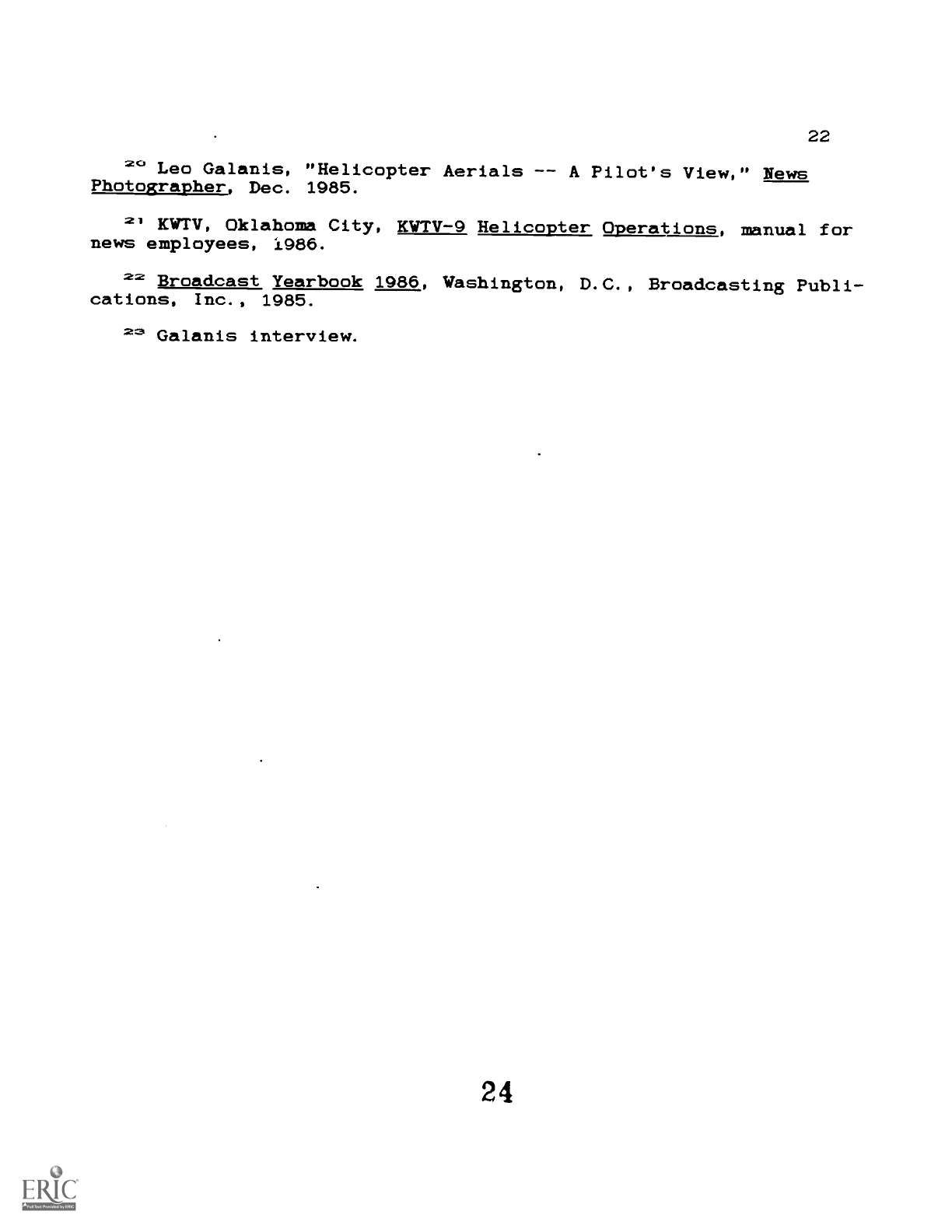
22
2° Leo Galanis, "Helicopter Aerials
A Pilot's View," News
Photographer, Dec. 1985.
2
KWTV, Oklahoma City, KVTV-9 Helicopter Operations, manual
for
news employees, 1986.
22 Broadcast Yearbook 1986, Washington, D.C.,
Broadcasting Publi-
cations, Inc., 1985.
2' Galanis interview.
24
